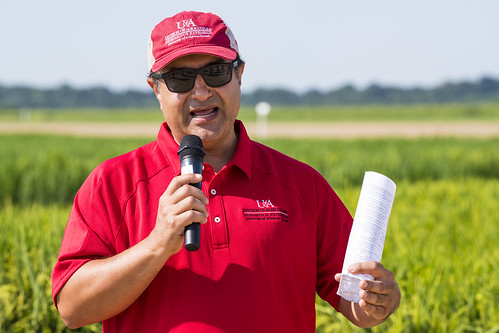Advances in rice breeding, management systems on display during field day
By Fred Miller
U of A System Division of Agriculture
@AgNews479
Fast Facts:
- Field day visitors had a first look at hybrid breeding lines
- Furrow-irrigated rice plots explore potential of reduced water use
(508 words)
Download related PHOTOS: https://flic.kr/s/aHsmFQPYy4
STUTTGART, Ark. — Visitors got a first look at advanced hybrid rice breeding lines and furrow-irrigated rice research plots at a Rice Research and Extension Center field day Aug. 2.

The field day featured these and other research and extension programs of the University of Arkansas System Division of Agriculture during two field tours. Besides a look at new rice varieties and advanced breeding lines, field tour topics covered weed management, multiple-inlet irrigation technology and management, soil fertility for rice, soybean breeding research and the use of drones in agriculture.
Ehsan Shakiba, assistant professor and hybrid rice breeder for the division’s Arkansas Agricultural Experiment Station, described his efforts to develop Arkansas-adapted hybrid rice varieties. He showed two advanced hybrid breeding lines in the center’s demonstration plots.
Hybrids typically have vigor and yield that is superior to their genetic parents, Shakiba said, usually exceeding yield of conventionally bred varieties by 15-20 percent. The two lines shown during the field day, XH124/129 and H-16-02, are no exception, he said. Both show high yield potential.
They were bred using two hybrid breeding methods, Shakiba said. XH124/129 is a three-line hybrid and H-16-02 is a two-line hybrid.
“Two-line hybrid breeding is a newer technology that makes breeding and handling easier,” Shakiba said. “It’s a simpler method to achieve the advanced characteristics of hybrid rice.”
Both are long-grain lines that have good disease resistance and thick straw to resist lodging. They have good milling quality and typical U.S. long-grain cooking and eating quality. XH124/129 also has short-season traits.
On another part of the Rice Research and Extension Center, Jarrod Hardke, Arkansas Cooperative Extension Service rice agronomist, and University of Arkansas graduate assistant Justin Chlapecka, showed their work in new research plots dedicated to furrow-irrigation for rice.
Hardke said one challenge furrow irrigation presents for rice growers is weed control. Most rice is grown in flooded fields where the water helps suppress weeds. Furrow irrigation, like that used in soybeans and other plants, can reduce water use, but requires weed control strategies similar to those other crops.
Hardke said he doesn’t envision furrow irrigation completely replacing traditional flooded rice fields, but it offers an alternative management system.
During an indoor presentation following the field tours, RREC director Bob Scott told visitors the research and innovation taking place on the center was aimed at improving profitability for Arkansas farms.
“Our mission is to investigate, validate and disseminate the best practices for sustainable production of rice and other crops for Arkansas farmers,” Scott said.
Nathan Slaton, assistant director of the Arkansas Agricultural Experiment Station, said field days offer an occasion for producers, consultants and other agricultural professionals to see, first-hand, the Division of Agriculture’s efforts to develop new technology and improved management practices to make Arkansas agriculture successful.
Field days offer the opportunity for farmers and others in the industry to speak with division scientists and administrators about the issues that are important to them, Slaton said. “Your feedback helps direct our research goals and drive new directions for study.”
To learn more about Division of Agriculture research, visit the Arkansas Agricultural Experiment Station website: https://aaes.uark.edu. Follow us on Twitter at @ArkAgResearchand Instagram at ArkAgResearch.
To learn about Extension Programsin Arkansas, contact your local Cooperative Extension Service agent or visitwww.uaex.uada.edu. Follow us on Twitter at @AR_Extension.
About the Division of Agriculture
The University of Arkansas System Division of Agriculture’s mission is to strengthen agriculture, communities, and families by connecting trusted research to the adoption of best practices. Through the Agricultural Experiment Station and the Cooperative Extension Service, the Division of Agriculture conducts research and extension work within the nation’s historic land grant education system.
The Division of Agriculture is one of 20 entities within the University of Arkansas System. It has offices in all 75 counties in Arkansas and faculty on five system campuses.
Pursuant to 7 CFR § 15.3, the University of Arkansas System Division of Agriculture offers all its Extension and Research programs and services (including employment) without regard to race, color, sex, national origin, religion, age, disability, marital or veteran status, genetic information, sexual preference, pregnancy or any other legally protected status, and is an equal opportunity institution.
Media Contact: Fred Miller
U of A Division of Agriculture
Arkansas Agricultural Experiment Station
(479) 575-5647
fmiller@uark.edu
Related Links